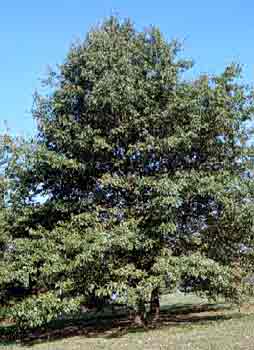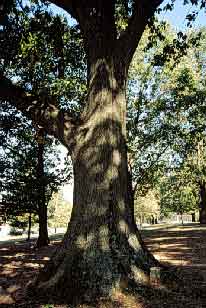 Shingle Oak - Quercus imbricaria
Shingle Oak - Quercus imbricaria
Beech Family (Fagaceae)
Shingle oak has dark green leaves without the typical lobes found in more recognizable oaks. It is most common in the outer Bluegrass and Knobs regions of Kentucky. The common name comes from the early practice of making shingles from the wood. The Kentucky champion tree is in Hopkins County and is over 100 feet tall.
 Culture: Shingle oak is an easy oak to grow and adapts to various sites. While it prefers rich, moist, acidic soil and full sun, it is tolerant of drought, urban conditions and slightly alkaline soil. Shingle oak is easy to transplant. Because of its very strong wood, this oak is not subject to storm damage. Shingle oak has few serious insect and disease problems, although potential problems include obscure scale, two-lined chestnut borer, bacterial leaf scorch, oak horn gall and gypsy moth. In addition, as little as 1 inch of fill soil can kill an oak.
Culture: Shingle oak is an easy oak to grow and adapts to various sites. While it prefers rich, moist, acidic soil and full sun, it is tolerant of drought, urban conditions and slightly alkaline soil. Shingle oak is easy to transplant. Because of its very strong wood, this oak is not subject to storm damage. Shingle oak has few serious insect and disease problems, although potential problems include obscure scale, two-lined chestnut borer, bacterial leaf scorch, oak horn gall and gypsy moth. In addition, as little as 1 inch of fill soil can kill an oak.
- Native habitat: Central and eastern North America in rich woods; Kentucky native.
- Growth habit: The tree is pyramidal when young but becomes wide-spreading with maturity.
- Tree size: Shingle oak will slowly attain a height of 50 to 60 feet with a similar or greater spread. It can reach 100 feet tall in the wild.
- Flower and fruit: Female flowers are in spikes; pendulous male catkins are yellow-green. The top half of the 5/8-inch-long acorn is covered by a cap of reddish-brown scales.
- Leaf: The willow-shaped leaves are 2½ to 6 inches long and 1 to 3 inches wide with a bristle on the end. They become yellow-brown to russet-red in autumn and persist on the tree through winter. The summer foliage is glossy green with a pale underside.
- Hardiness: Winter hardy to USDA Zone 4.
Shingle oak may be one of the best oaks, but it is not commonly used. It makes a good park or street tree. Because it adapts to pruning and has persistent leaves, it is useful as a hedge.
The leaves on shingle oak are glossy green and are not lobed. They are attractive all summer long.
Early settlers in North America used this tree to make shingles, leading to the common name - shingle oak. The species name - imbricaria - is derived from the Latin word imbricatus, which means overlapping.
Shingle oak is native to the central and eastern U.S. and tends to grow to 50 to 60 feet tall. Co-national champion trees are in Cincinnati, Ohio (105 feet) and Nashville, Tenn. (107 feet).


